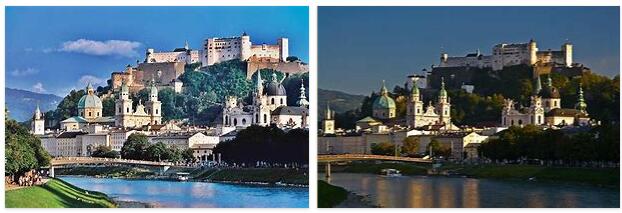
Salzburg, federal state in western Austria, bordering Germany (Bavaria) in the northwest, encompassing the Berchtesgadener Land on three sides; 7 156 km 2, (2017) 549 300 residents; Salzburg is divided into five districts and the capital Salzburg with its own statute.
In the north and north-east of Salzburg borders on Upper Austria, in the southeast of the Steiermark (the tri-border region in the Dachstein), in the eastern south of Carinthia, on the west by Tyrol and western south on the part of the country Tyrol, in between, there is the valley of the Ahr valley a short Border (about 10 km) with Italy (South Tyrol).
Traffic
Salzburg is connected to the east and north of the transport network between Vienna and Munich (motorway, railroad, federal highways). The main regional traffic artery runs through the Salzach Valley, the Zell am See basin and over the Grießenpass in a westward direction to Tyrol (federal highways and railways). To the south over the main Alpine ridge, the most important traffic connections are the Tauern Autobahn (tunnel) as the second most important Austrian north-south transit route after the Brenner, the Grossglockner High Alpine Road, the Felber-Tauern Road (tunnel) and the Tauern Railway. An international airport is available for air traffic near Salzburg.
Law
According to the State Constitutional Act of 1999 (amended several times), the legislature exercises a state parliament with 36 members that is elected for five years. The executive is incumbent on the state government elected by the state parliament, which consists of the state governor, two state governor deputies and four state councilors.
Flag and coat of arms: The national flag was legally established on February 16, 1921. It is divided into two equal bars of red over white and bears the national coat of arms in the middle. – The coat of arms was also determined in 1921. It is probably derived from the family coat of arms of Archbishop Ulrich (1246–56) from the ducal house of Carinthia; it has been proven since Archbishop Rudolf (1284–90). In the split shield, it shows an upright, red-tongued and armored, black lion in heraldic right, and a silver bar in red on the left. A prince’s hat has been on the shield since 1805, when Salzburg became the crown land.
Geography
Salzburg extends from the main Alpine ridge of the Hohen Tauern (Großvenediger, Glockner, Ankogel, Hafner groups), in the southeast still south of the Schladminger Tauern, encompassing the area around the uppermost Mur (Lungau), over the valleys of the upper Salzach and Saalach (Pinzgau, Pongau, the latter reaching into the valley of the upper Enns) and parts of the Salzburg Limestone Alps (Tennengau) as far as the Alpine foothills east of the Salzach (Flachgau). Without its capital, Salzburg is thus divided into five parts of the country (Gaue), which represent clearly separate individualities and are anchored in the regional identity of the residents.
Climate: The course of the weather is mainly determined by the northwest currents, which dump their moisture on the northern edge of the Alps and on the main Alpine ridge (in the cold season as snow). Salzburg and the Salzkammergut register 1,300–2,500 mm of precipitation annually (in 13–17 rainy days per month), while parts of the Pinzgau and especially the intramontane basin of the Lungau have very little precipitation (the latter 800 mm annually). In terms of temperature, the north is clearly preferred with mean temperatures of −2 ° C in January and 17-18 ° C in July and August. Due to the frequent formation of cold air lakes in winter, the Lungau has also been nicknamed »Austrian Siberia«.
Population
The main settlement area is the Alpine foothills (with the core area Salzburg / Hallein), where over 60% of the population live. In the Alps, the settlements are essentially limited to the valleys (Salzach, Saalach, Gasteiner Ache, Lammer, Enns, Mur). Only around 20% of the country’s area (1,496 km 2) is permanent settlement; In relation to this area, the population density is 367 residents / km 2. In 2016, both the birth balance and the migration balance in the state were positive (+ 1 215 and + 4 742 people, respectively). In the rural districts, population growth is largely based on a surplus of births (more live births than deaths), in the city of Salzburg, on the other hand, it is mainly due to migration. The central local importance of the capital extends into the western Innviertel and the upper Ennstal as well as into the bordering Bavaria. Inner-alpine centers are Bischofshofen, Sankt Johann im Pongau, Zell am See, Saalfelden am Steinernen Meer and Bad Gastein.
Religion: The last census to collect data on religious affiliation was in 2001. At that time around 74% of the population were Catholic and around 4.4% Protestant. Since then, only the number of members of individual religious communities can be used as a basis. The Catholics are assigned to the Archdiocese of Salzburg, which includes the federal state of Salzburg and the north-east of Tyrol (2015: a total of 473 022 members). In 2012, Islam was the second largest religious community with an estimated 35,000 believers (source: statista). The Protestant Christians belong to the Evangelical Church of the Augsburg and Helvetic Confessions in Austria (Cross-state superintendency [diocese] Salzburg and Tyrol). There is a Jewish community in Salzburg (“Israelitische Kultusgemeinde Salzburg”).